BRISTOL MOTOR SPEEDWAY - BRISTOL TN

Formerly known as Bristol International Raceway and Bristol Raceway, is a NASCAR short track venue located in Bristol, Tennessee. The land upon which Bristol Motor Speedway is built was formerly part of Gray's Dairy, at one point one of the largest dairies in the eastern half of the United States. Larry Carrier and Carl Moore traveled to Charlotte Motor Speedway in 1960 to watch a race and it was then that they decided to build a speedway in northeast Tennessee. However, they wanted a smaller model of CMS, something with a more intimate setting and opted to erect a 1/2 mile facility. Work began on what was then called Bristol International Speedway in 1960 and it took approximately one year to finish. Carrier, Moore and Pope scratched many ideas for the
track on envelopes and brown paper bags. Purchase of the land on which BMS now sits, as well as initial construction of the track, cost approximately $600,000. The entire layout for BMS covered 100 acres and provided parking for more than 12,000 cars. The track itself was a perfect 1/2 mile, measuring 60 feet wide on the straightaways, 75 feet wide in the turns, and the turns were banked at 22 degrees. Prior to the first Cup race held at the track; the facility hosted weekly events. The first Cup driver on the track for practice on July 27, 1961 was Tiny Lund in his Pontiac. Atlanta's Jack Smith won the inaugural event – the Volunteer 500 – at BMS on July 30, 1961. However, Smith was not in the driver's seat of the Pontiac when the race ended. Smith drove the first 290 laps then had to have Johnny Allen, also of Atlanta, take over as his relief
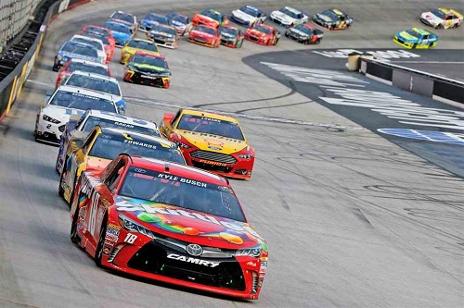
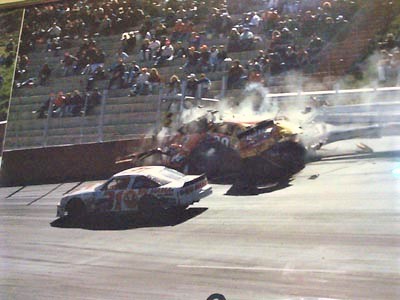
driver. Country music star Brenda Lee, who was 17 at the time, sang the national anthem for the first race at BMS. In 1961, the track hosted a National Football League preseason game between the Philadelphia Eagles and Washington Redskins. In the fall of 1969, BMS was reshaped and re-measured. The turns were banked at 36 degrees and it became a 0.533-mile oval. The speedway was sold after the 1976 season to Lanny Hester and Gary Baker. In the spring of 1978, the track name was changed to Bristol International Raceway. In August that year, the first night race was held on the oval, one that would become one of the most popular and highly anticipated events on the Cup Series calendar. As far as NASCAR results, No driver had more success at Bristol than Darrell Waltrip. Waltrip has 12 wins at the track; getting seven wins in a row from 1981-1984. Dale Earnhardt Sr claimed nine wins at the tight little short track. Rusty Wallace
also got nine wins over a 14 year span. Cale Yarborough won nine times; eight of those wins coming in a 12 race stretch from 1973-1978. David Pearson, Kyle Busch, Kurt Busch, and Jeff Gordon all got five wins. In 1990 Michael Waltrip had a death-defying crash at Bristol where he destroyed his Xfinity series car. He hit a gate that was in the outside wall at the exit of turn two (picture above). The gate was used to allow vehicles in and out of the infield because the track did not have a tunnel. The impact broke the gate, and Michael went head-on into the end of the wall, disintegrating the car on impact and collapsing the car into itself. What was left of the car is pictured at right. Onlookers were sure that Waltrip was severely injured, perhaps fatally, because of how massive the impact; as his brother Darrell rushed to the wreck fearing the worst. Amazingly, Waltrip survived the accident and he only
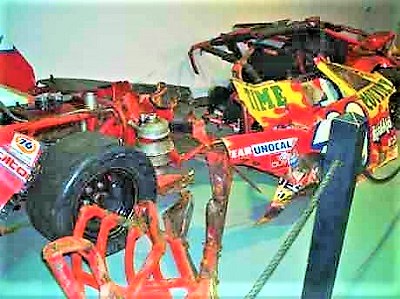
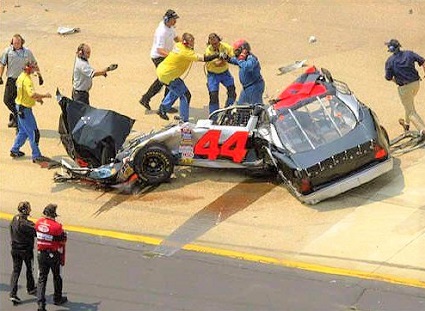
suffered cuts, soreness, and bruises in the wreck. After Mike Harmon had an almost identical impact several years later (and also amazingly walked away), the gate was moved down to just before the entrance of Turn 3, thus lessening the chance of a car hitting it (Harmon photo at left). For many years, teams were unable to park their transporters inside the infield, nor did the track have any significant garage area. Team transporters were parked in a lot outside of the track. During racing periods, crews and participants were landlocked by the track, and thus, unable to return to the transporters for spare parts, repairs, or rest. In the early 1990s, the infield was reconfigured and completely paved. Teams began parking the transporters in an orchestrated, extremely tight arrangement that takes several hours, and highly skilled drivers, to accomplish. Teams are now able to work out of
their transporters in the same fashion as other facilities. In 1992, the speedway abandoned the asphalt surface that it had used since its inception, switching to the concrete surface it is now famous for. In 1995, Lights were installed around the track to run races with permanently installed lights instead of the use of trucks with temporary lighting which was used for the Bass Pro Shops NRA Night Race from 1978 to 1994. On January 22, 1996, Larry Carrier sold the speedway to Bruton Smith's Speedway Motorsports, Inc. (SMI), at a purchase price of $26 million. On May 28 of the same year, the track's name was officially changed to Bristol Motor Speedway. BMS continued to grow and by April
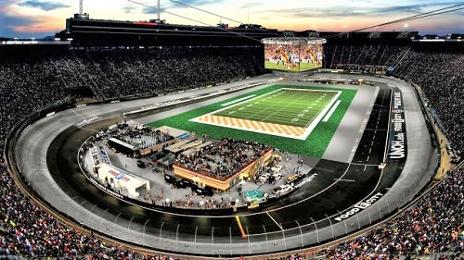
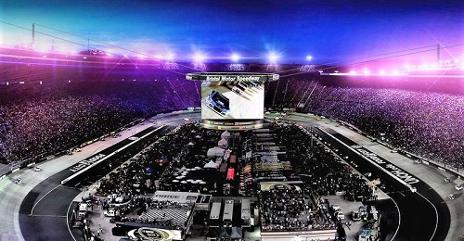
1997, it was the largest sports arena in Tennessee--surpassing the University of Tennessee's 102,000 seat Neyland Stadium (college football)--and one of the largest in the country, seating 118,000. Under Smith's ownership, all seating sections have been renamed for past race winners and NASCAR champions. In both 2000 and 2001, the track was temporarily converted to a dirt track to host the World of Outlaws' Channellock Challenge. The conversion involved moving 8,000 cubic feet of red clay onto the track's surface. 700 cubic yards of sawdust were laid down first to cover the paved surface. The track was
was widened by 12 feet to 14 feet and the banking was reduced from 36° to somewhere between 22° to 24. In 2002, improvements included a scoring pylon with a four-sided video screen akin to those in sports arenas hanging from their ceilings; after the 2007 Food City 500, a resurfacing of the entire concrete track along with widening the track three feet and reshaping the turns with variable banking. On the week ending August 21, 2010, Kyle Busch became the first driver ever to win races in all three NASCAR national series during a single race meeting. Busch would repeat this feat at Bristol in 2017, again winning all 3 races during a single race weekend. In 2016 the scoring pylon was replaced by a large 4-sided display hung by cables over the center of the infield. Named "Colossus TV", the track claims it is the largest outdoor-hung display of its kind in the world, with each screen measuring 30 feet by 63 feet. In non-motorsports usage Bristol has hosted various things. In the fall of 2002, students from Sullivan East High School in Bluff City, Tennessee attended the skyboxes at the Speedway as temporary school facilities, due to an outbreak of black mold that closed the school for nearly 6 weeks. In October 2010, Remote Area Medical held a health clinic on the infield of the track, providing free vision, dental and general-medical care to people who do not have medical insurance. Bristol Motor Speedway has opened their campgrounds to evacuees of hurricanes, including during Hurricane Irma in 2017, Hurricane Florence in 2018, and Hurricane Dorian in 2019. On October 14, 2013, after years of attempts to schedule a game, Virginia Tech, UT, and Bristol Motor Speedway announced plans for the game to be held on Saturday, September 10, 2016. Bristol Motor Speedway's location near the Virginia/Tennessee state line placed the game about 125 miles from the Virginia Tech campus in Blacksburg, Virginia and about 110 miles from the UT campus in Knoxville. The game, won 45–24 by the Volunteers, drew an announced crowd of 156,990, breaking the previous record by more than 40,000.
All Photos copyright and are property of their respective owners
